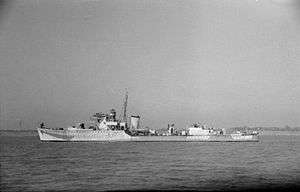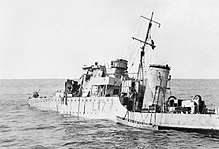HMS Berkeley (L17)
HMS Berkeley was a Type I Hunt-class destroyer of the Royal Navy. She was a member of the first subgroup of the Hunt class and saw service in World War II before being bombed at Dieppe and then scuttled by HMS Albrighton.[1]
 | |
| History | |
|---|---|
| Name: | HMS Berkeley |
| Namesake: | A fox hunt in Gloucestershire, England |
| Builder: | Cammell Laird, Birkenhead |
| Laid down: | 8 June 1939 |
| Launched: | 29 January 1940 |
| Completed: | 6 June 1940 |
| Commissioned: | 6 June 1940 |
| Identification: | pennant number: L17 |
| Motto: | Dieu avec nous |
| Honours and awards: | |
| Fate: | scuttled 19 August 1942 |
| Badge: | On a Field Gold. Upon a Red roundel, in front of two hunting horns in saltire gold and a cross patee white. |
| General characteristics | |
| Class and type: | Hunt-class destroyer |
| Displacement: |
|
| Length: | 280 ft (85 m) |
| Beam: | 29 ft (8.8 m) |
| Draught: | 10 ft 9 in (3.28 m) |
| Propulsion: |
|
| Speed: | 27.5 knots (50.9 km/h; 31.6 mph) |
| Range: | 3,500 nmi (6,480 km) at 15 knots (28 km/h) / 1,000 nmi (2,000 km) at 26 knots (48 km/h) |
| Complement: | 146 |
| Armament: |
|
Construction
Berkeley was ordered from Cammell Laird in the 1939 Build Programme and laid down on 8 June 1939 as No. J3302. She was launched on 29 January 1940 and commissioned on 6 June 1940, Lieutenant Commander Hugh Walters in command.[2]
Career

Berkeley participated in Operation Ariel, the evacuation of the remnants of the British Expeditionary Force from ports in western France. She was made available to Paul Reynaud and the French government for conferences with Churchill. After the Fall of France, she evacuated the remaining British embassy staff as well as Władysław Raczkiewicz and Polish and Czech troops.
In August 1940, Berkeley escorted minelayers during minelaying Operation SN32. She spent September on anti-invasion patrols in the English Channel. She escorted convoys in October and November. On 20 December 1940, she was damaged by a mine in the Medway and was repaired at Chatham Dockyard.
After the repairs were completed, Berkeley resumed convoy escort duties in January 1941. On 22 February, she escorted HMS Icarus during the minelaying Operation JK off the French coast. For the rest of the year, Berkeley escorted convoys and patrolled the English Channel. In February 1942, she participated in the unsuccessful attempt to intercept the German battleships Scharnhorst and Gneisenau during the Channel Dash. Lieutenant James York became her commander on 27 March 1942.[2] Berkeley continued convoy escort duties until July 1942, when she was selected to be part of the naval force supporting Operation Jubilee. On 18 August 1942, Berkeley escorted the Dieppe raiding force.[3] During a 19 August air attack, she was hit by two bombs dropped from Focke-Wulf Fw 190s,[4] which broke her keel and killed 13 ratings.[5] As the damage was beyond control, she was abandoned and then scuttled by torpedoes from the escort destroyer Albrighton.[6][7]
References
- "HMS Berkeley, escort destroyer, WW2". www.naval-history.net. Retrieved 4 April 2015.
- "HMS Berkeley (L 17) of the Royal Navy - British Escort destroyer of the Hunt (Type I) class - Allied Warships of WWII - uboat.net". www.uboat.net. Retrieved 4 April 2015.
- Zuehlke, Mark (2 April 2013). Tragedy at Dieppe: Operation Jubilee, August 19, 1942. Douglas & McIntyre. ISBN 9781553658351.
- Goss, Chris; Cornwell, Peter; Rauchbach, Bernd (1 January 2010). Luftwaffe Fighter-Bombers Over Britain: The Tip and Run Campaign, 1942-43. Stackpole Books. ISBN 9780811706919.
- "HMS Berkeley". www.hmscavalier.org.uk. Retrieved 4 April 2015.
- Grehan, John; Mace, Martin (18 June 2014). Liberating Europe: D-Day to Victory in Europe 1944-1945. Pen and Sword. ISBN 9781473838277.
- Neillands, Robin (1 January 2005). The Dieppe Raid: The Story of the Disastrous 1942 Expedition. Indiana University Press. ISBN 0253347815.
Publications
- Colledge, J. J.; Warlow, Ben (2006) [1969]. Ships of the Royal Navy: The Complete Record of all Fighting Ships of the Royal Navy (Rev. ed.). London: Chatham Publishing. ISBN 978-1-86176-281-8.
- English, John (1987). The Hunts: A history of the design, development and careers of the 86 destroyers of this class built for the Royal and Allied Navies during World War II. World Ship Society. ISBN 0-905617-44-4.
External links
| Wikimedia Commons has media related to HMS Berkeley (ship, 1940). |